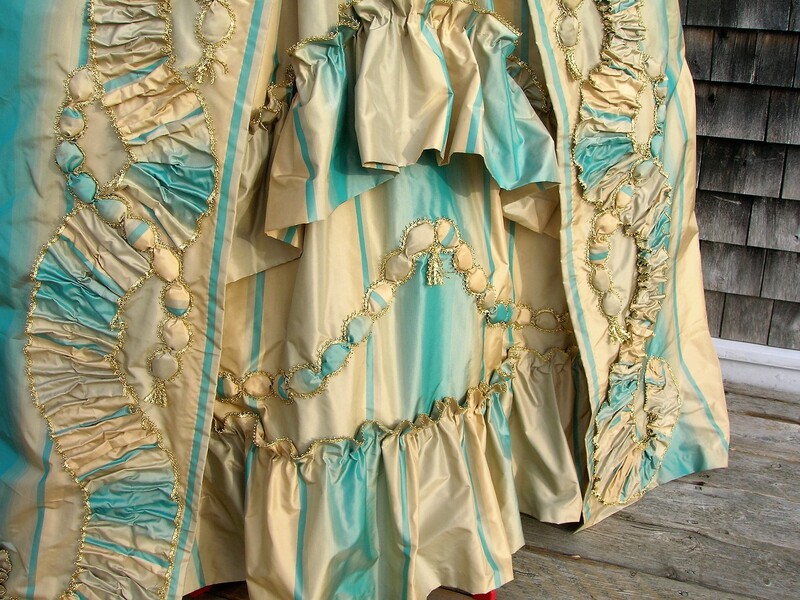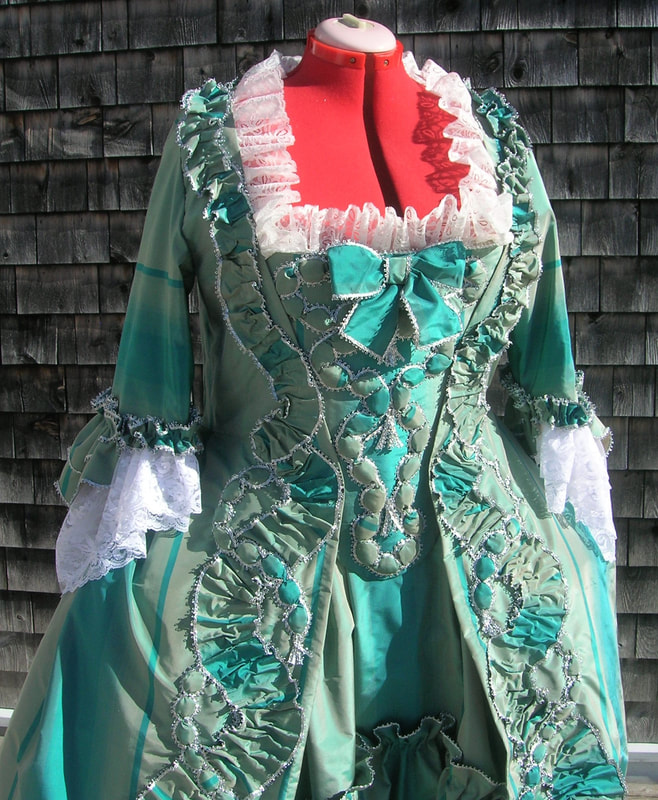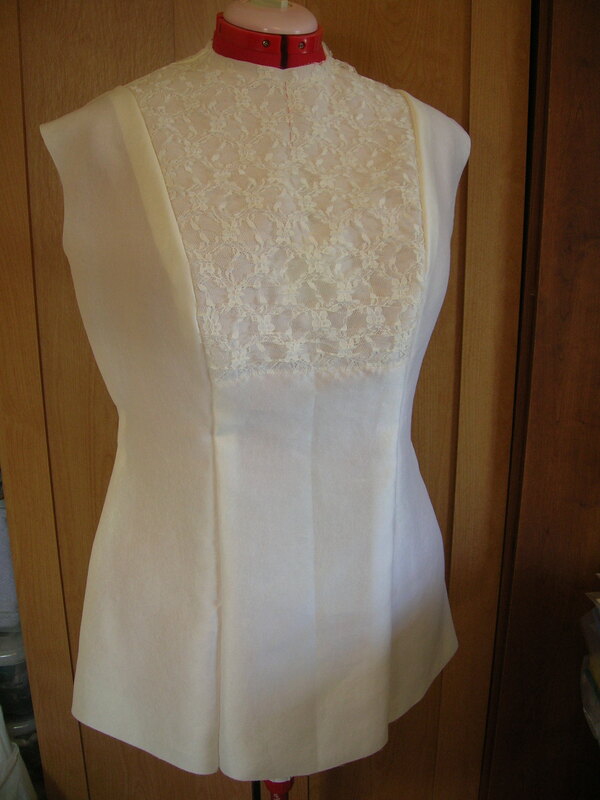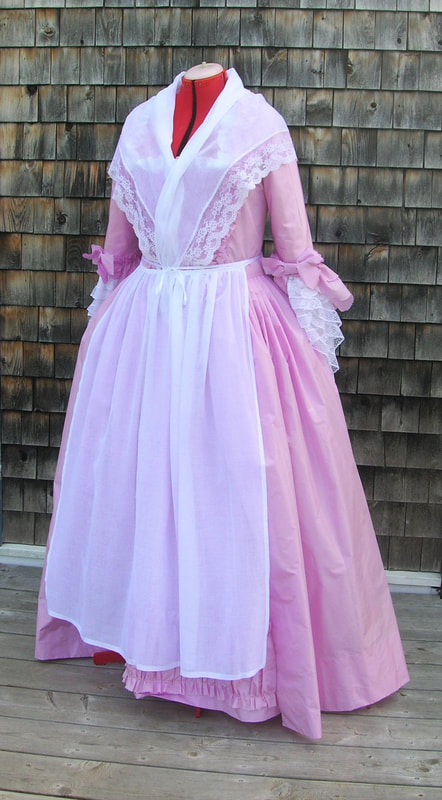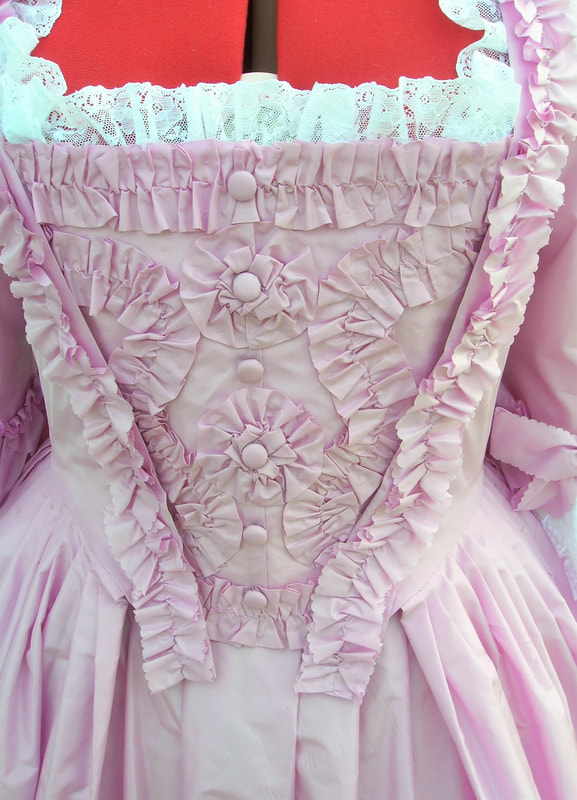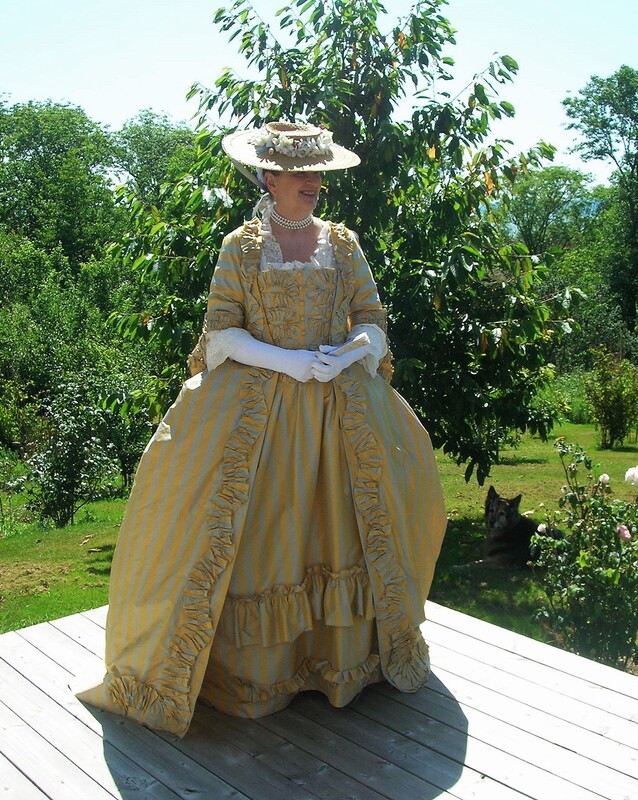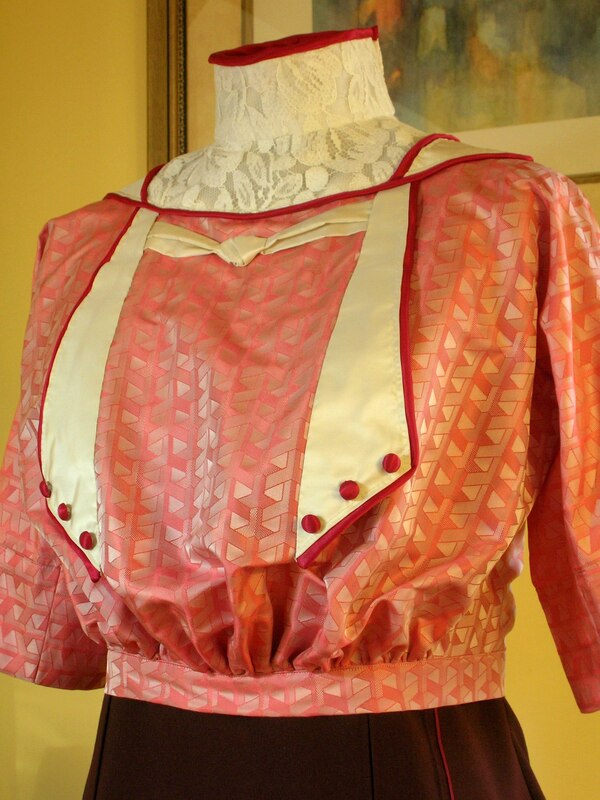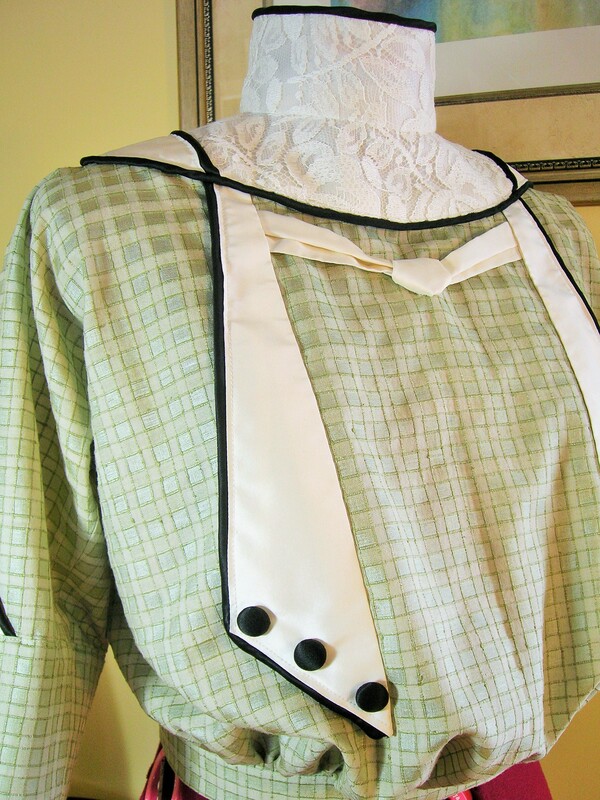The first was made of a beautiful soft turquoise and gold silk iridescent taffeta in broad, subtle stripes, lavishing trimmed with furbelows, ruched meanders, and puffings, all of which was edged in fine gold trim. Every bit of the gown was constructed by hand, a labour of love of well over 200 hours. This gown sold -- and she went to the Fêtes Galantes at Versailles!
The second gown shown here is also of iridescent silk taffeta, but with broad bands of darker and lighter teal, creating an overall deep teal impression. I made some structural and design changes on this gown as compared to the previous one, and used silver edging all over, rather than gold. The effect is more muted, but I liked the combination of silver and deep teal. It's perhaps not quite as impressive and fancy as the other gown, but still very elegant.
One thing is true though: the camera was incapable of capturing the true scintillating effect of these silk gowns. In real life they are much more beautiful than still photos are able to depict. Photos taken below in both cloudy and sunny outdoor lighting conditions demonstrate what a difference the lighting can have on silk taffeta.
One thing is true though: the camera was incapable of capturing the true scintillating effect of these silk gowns. In real life they are much more beautiful than still photos are able to depict. Photos taken below in both cloudy and sunny outdoor lighting conditions demonstrate what a difference the lighting can have on silk taffeta.
In the meantime, here is my robe à la polonaise that almost exactly replicates a ca. 1775 extant gown in the collection of the Victoria & Albert Museum (U.K.). The museum indicates that the original gown is of Scottish origin, which seemed ideal for my planned portrayal of a middle/upper middle class Scottish lady of the 1770's.
The gown is in the "long-back English gown" style which persisted through several decades of the 18thC., first in early 1730's mantuas, and later (1780's) in many of the gowns worn with rumps to create an exaggerated back silhouette.
Since my replica was intended to be worn "à la polonaise", it has only a very short train at back. In retrospect, I would have made the entire gown floor length, but fortunately the tissue-taffeta like hand of the silk allows for the back to be pulled up and stay "puffed up" in place quite easily.
This gown was relatively simple from a construction viewpoint, with a centre front hook and eye closure and minimal surface decoration based on the V&A original. I began with my usual English gown linen lining (foundation), and added lacing panels below the front closure for extra security, a feature seen in a number of extant gowns of the era. The long centre back panel was pleated onto the linen lining, with the folds opening into the back skirts below the waistline. The rest of the skirts were very finely pleated into the bodice.
Although I do have a gold-coloured silk taffeta petticoat that is close to the one displayed in the V&A photos, I decided to make a petticoat from some lovely shot silk dupioni taffeta that almost exactly matches the old rose colour in the stripes of the gown. My gown fabric was also a low-slub, quality striped silk dupioni with a whisper-like weight and fine, crisp texture.
My only disappointment with this gown: unfortunately the striped dupioni did not take well to pinking: the edges of most of my applied ruching almost immediately began to fray and shred! Lesson learned (I really should have known better). Next time I use dupioni, all the edges of the trim will be turned under and hemmed first, then ruched or pleated -- without the pinking!
Update: As it turned out, the shredded edges of the trim bothered me so much that I decided to remove all the original pleated trim, then re-cut and make new trim, turning all the edges under a scant 0.5cm and hand-hemming them before pleating and hand-sewing them onto the gown. I'm now glad I spent the time and effort fixing it, as I no longer have to worry about messy and embarrassing looking strings of frayed silk trailing from my bodice, and the trim disintegrating and disappearing as I walked! Dupioni does not behave for all those lovely pinked 18thC. furbelows.
My only disappointment with this gown: unfortunately the striped dupioni did not take well to pinking: the edges of most of my applied ruching almost immediately began to fray and shred! Lesson learned (I really should have known better). Next time I use dupioni, all the edges of the trim will be turned under and hemmed first, then ruched or pleated -- without the pinking!
Update: As it turned out, the shredded edges of the trim bothered me so much that I decided to remove all the original pleated trim, then re-cut and make new trim, turning all the edges under a scant 0.5cm and hand-hemming them before pleating and hand-sewing them onto the gown. I'm now glad I spent the time and effort fixing it, as I no longer have to worry about messy and embarrassing looking strings of frayed silk trailing from my bodice, and the trim disintegrating and disappearing as I walked! Dupioni does not behave for all those lovely pinked 18thC. furbelows.
However, there were occasions where a formal appearance was called for, but in a less formal setting. This gown is in that category, appropriate as a visiting, reception, or dinner gown. As an evening gown for dinner, in velvet (as I made the replica) or silk, despite the luxe of the textiles, its high collar would signify informal evening wear -- a gown appropriate for a fancy dinner at home, or with close friends. As a visiting or afternoon gown, it would speak to the highest formality of day wear, whether in velvet or not.
This replica was made from silk/rayon velvet in a deep forest green colour, over a full, boned foundation, with hand embroidered insets (plastrons), French cotton guipure lace, and silk satin bias trim. This is a true "Gibson Girl" gown, with a semi-hobble skirt formed by the applied band below the knees. The band can also be omitted, to create a typical trained skirt.
The pattern for this afternoon gown is available in my Etsy shop. This design is best suited to those with fairly advanced sewing skills, especially if the gown is made in velvet. Click on this button to go to the Etsy listing:
If you're planning to work with velvet and would like some tips and insights into handling this luxury textile, see my blog article here:
This robe à la française was no exception. Made from a luscious iridescent silk taffeta of blue tones shot with golden coloured weft threads, the textile has a trompe l'oeil character: from any distance the blue and gold threads of the weave merge so that the overall appearance is a soft, warm taupe with bands of warm grey.
But up close the colour shimmers and shifts. It almost has a sparkling effect! So what I initially thought was a rather dull-coloured fabric has turned out to be a stunning textile, especially against the metallic gold trim. The 18th century embellishments of ruching, puffings, and flounces serve to magnify the shimmering effect of the silk.
This gown was styled after a (presumed) French sacque gown currently in a German collection. The type of gown, with its extensive embellishment and metallic edging trim, would have been fashionable for evening wear by wealthier classes in the mid-18thC.
Unfortunately, cameras have a difficult time capturing the true effect of iridescent or shot silk. You'll see the difference below, between photos taken of the gown in light shade and the pictures at the end taken in bright sunlight. It was almost too much shimmer and shine in full sunlight -- this is a gown meant for candlelight!
See my notes on creating this taupe gown under the "Blog" heading!
Besides, I felt the cotton fabric was a better, more comfortable (and washable!) choice for upcoming summer wear, when we all hoped Covid might disappear and historical events re-appear. Alas, Covid had other ideas. But being ever the incurable optimist, I made the gown anyway, and the bright, cheery, positive colour of the cotton fabric made it all the more enjoyable to work with.
Some photos of me wearing the gown on a blustery spring day in 2021 are included in my comical blog/video at the link below, but I've also added pictures here for reference.
This gown was cut in the "long-back" English style, and worn over my "go-to" iridescent yellow taffeta petticoat. Incidentally, please don't use "en fourreau" when referring to these types of gowns -- to see why, read my academic paper on the subject here:
All in all, this gown was a simple and fun project at a time when I needed distraction in the depths of the Covid pandemic. I'm still hoping I may have a chance to enjoy wearing it at a live event!
To read all the details of constructing this ensemble -- consisting of petticoat, stomacher (faux compère), gown, engageantes, tucker, apron, and fichu -- click on the link below to Part 1 of my blog article, which includes photos documenting the construction steps. Parts 2 through 4 follow the project to completion.
This was a true labour of love, in a colour I normally would never be drawn to (orchid pink), but which, in the end result, seemed just the right choice for this ensemble.
This was a true labour of love, in a colour I normally would never be drawn to (orchid pink), but which, in the end result, seemed just the right choice for this ensemble.
My favourite sacque of those I've made is this yellow and silver striped taffeta gown, constructed as closely as possible after an extant gown from a private collection. I was fortunate enough to be able to enjoy wearing it at the 18thC. "Natal Days" celebration in our historic town of Annapolis Royal in August, 2019, just before Covid hit. Since that time, the annual event has not been held due to public health measures.
A small collection of photos is included below (most taken at historic Fort Anne), but to see and read much more about its making, go to my blog article here:
Blouses and shirtwaists of the 1910's were the staple of every woman's wardrobe. Batiste and linen blouses or shirt-waists were everywhere, some with the more formal high, fitted and boned collars, some with the fairly recently acceptable open necklines (especially for warmer weather). These types were most often worn under walking suits, while more dressy silk blouses could stand on their own with a lovely tailored skirt, even as an informal dinner ensemble. Generally the less fancy shirt-waists closed at front, but blouses closed at centre back -- meaning a maid or other helper was necessary to get dressed!
The blouses shown here range across the spectrum from rather plain, tailored shirtwaists to the fancier silk blouses. In some cases I made more than one version, usually the initial one as close to the antique colours as possible, and then another on commission in colours specified by the client.
I am still in the process of completing patterns for at least two of these designs -- look for them soon in my Etsy shop! The rest are currently available as sewing patterns (see the pattern cover art included with the images, and use the button link below to access my Etsy shop).
I am still in the process of completing patterns for at least two of these designs -- look for them soon in my Etsy shop! The rest are currently available as sewing patterns (see the pattern cover art included with the images, and use the button link below to access my Etsy shop).
I was originally planning to develop this design as a sewing pattern, but realized after making it that the construction was probably too complex, and that the pattern would really only be feasible for advanced sewists with historical sewing experience. I may still change my mind!
As with almost all silk dresses of the era, this one is built over a closely-fitted boned foundation, and with complicated asymmetrical closures. I've included a short video below which I made to demonstrate the closure arrangements on this gown, which were, despite their complexity, not uncommon in dresses of the 1910's.
This was a project I had wanted to make for a long time, so I was happy to receive a commission to reproduce it. This request came from a client who was a joy to work with, as she understood and valued historical accuracy and was willing to follow my advice on materials and trim. The result -- an almost perfect replica of the original 1884 French ball gown.
The gown was made of a soft, flowing silk/rayon velvet in a deep plum colour, with matching silk satin contrast and drapery. The underskirt was fashioned from cream silk shantung with tiers of reproduction Victorian lace. The bodice was lined with ecru silk taffeta and was fully boned with "synthetic whalebone". I underlined the long train with muslin and lined it with cream silk satin, as well as adding a tulle "pouf" under the top of the skirt to enhance the bustle silhouette. Although the gown gives the impression of a seamless, one-piece dress, it has in fact a separate bodice and skirt.
Altogether about 9.5 metres of 110cm wide velvet, about 5.0m of silk satin, and 1.5m of silk taffeta went into this gown -- quite an investment in materials!
Altogether about 9.5 metres of 110cm wide velvet, about 5.0m of silk satin, and 1.5m of silk taffeta went into this gown -- quite an investment in materials!
Of course the beautifully draped and softly arranged appearance of the outside of the gown belies all the structure underneath! On my recommendation, the client commissioned me to make a "lobster cage" style tournure, made of sturdily boned, crisp cotton percale, to wear to support the shape of the gown. Unfortunately I ran out of time to photograph the support garment, but I've included the original ca.1882 French fashion sketch of it here.
The one element of this gown that I might have altered if I'd had the time was the "pouf" built into the underside of the train (at upper back). It could have been larger! Unfortunately the weight of the long train was such that it did slightly flatten the effect of the waterfall bustle at the top.
I've wanted to reproduce this same ensemble again, but this time in an extravagant wine-red silk/rayon velvet! This design is on my priority list for pattern development for my proposed "Master Class" line of patterns.










